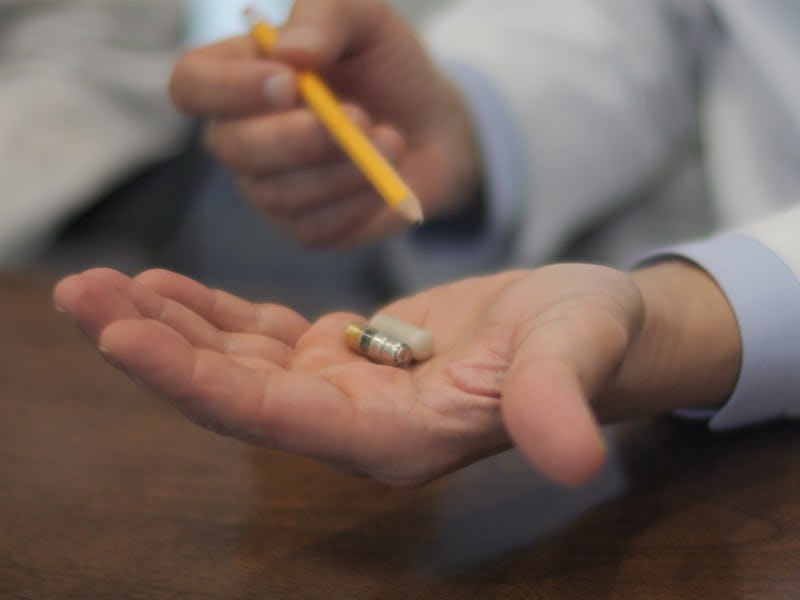This New “Robot” Pill Can Track Your Heart Rate And Knows If You Stop Breathing
A group of researchers published the results of the first in-human trial of a vitals-monitoring pill.

Pills are not just for taking a vitamin or relieving pain anymore. Devices like the PillCam and the SmartPill can help doctors detect and monitor diseases in areas of the gastrointestinal tract that they can’t easily reach. And engineers are constantly developing new advancements. These “technopills” could change the way we collect health data and even treat diseases.
Now, a group of researchers published the results of the first in-human trial of a vitals-monitoring pill in the journal Devices. This tiny, swallowable tool can currently detect vital signs like heart rate and breathing, and its creators think that one day, it could aid in everything from diagnosing sleep disorders to reversing opiate overdoses.
Easy breathing
The new paper, by researchers from Massachusetts Institute of Technology, West Virginia University, University of Pittsburgh, and digital health platform Celero Systems, shows how these capsules garnered respiratory data from 10 participants as they slept. People who undergo sleep studies usually spend at least one night at a clinic, wired to a bevy of monitors that track breathing, heart rate, and other vital signs.
“Everybody takes pills,” co-author Ali Rezai, a neuroscience professor at West Virginia University’s Rockefeller Neuroscience Institute, said during a press conference. “That pill can now monitor breathing, heart rate, temperature of the body, as well as movements of the intestines.”
Upon swallowing the capsule, each participant alternated between breathing normally and holding their breath for 15 seconds each. Whenever someone held their breath, respiratory waveforms that the capsule picked up ceased, demonstrating that the pill could accurately note whenever breathing halted.
Since this pill can monitor breathing from inside someone’s body, its applications range from sleep disorder diagnosis to opioid overdose reversal. As a way to track sleep, the capsule can collect a week of continuous data on how someone breathes as they rest, which could become a more convenient way to diagnose different types of sleep apnea, as the study tested for.
However, these sleep study participants could also simulate the sort of breathing cessation that might occur in the case of an opioid overdose. The fact that this study successfully tracked breathing cessation in sleep apnea means it could do the same if someone stops breathing from an overdose.
Open wide
Stretching about the diameter of a quarter, the pill includes two ingestible tiny batteries, an accelerometer, data storage, a radio transmitter, and a magnet-sensitive circuit that turns the gadget on and off — all wrapped in a biocompatible shell. Once in the digestive tract, it transmits data on ballistic movements, like heartbeats, to an external receiver connected to a laptop. At the press conference, Celero Systems founder, director, and CEO Benjamin Pless said that right now, the capsule’s wireless capabilities extend only two meters, but plan to increase that. The idea, the company claims, is for real-time data to appear on the user’s phone, which likely would be within a two-meter range.
In the case of overdose prevention, there would be one critical addition to this pill. It could come with a dose of naloxone, the opioid antagonist medication used to reverse overdoses, and would administer the treatment upon detecting breathing cessation. This innovation means that those with opioid addictions and those who take prescribed opiates could take them safely alone with a much lower risk of death by overdose. While the team has not yet attempted to reverse opioid overdose in humans, they say they have successfully done so in pigs.
Two weeks following the study, the capsule had passed through all 10 participants’ digestive tracts. In prescribed use, Pless said a patient would ideally take one capsule every week to reside in the stomach. Wireless controls can increase the pill’s size such that the device wouldn’t be large enough to pass through the stomach’s pyloric valve, which is the door, essentially, between the stomach and small intestine. This way, this single-use pill could continuously monitor respiratory data for an entire week, rather than the brief window it would get in the digestive tract naturally. Pless also pointed out that all electronic devices can malfunction. In this capsule’s case, it’s designed to fall apart after a week to easily pass.
The device is still a ways off from being routinely used in humans. Pless said he anticipated another two years of clinical trials before, if all goes well, potentially bringing this innovation to market. Pless’ broader hope for this technology is that it democratizes access to health evaluations. He noted that not everyone lives near a clinic or can spend multiple nights hooked up to monitors. Ideally, a patient could receive this pill in the mail and set it up themselves.